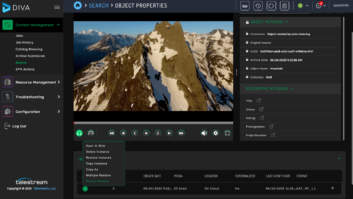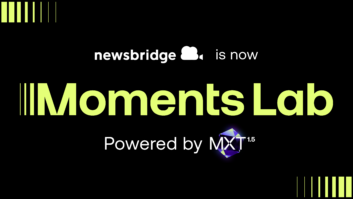
The cloud offers a way of outsourcing that is flexible, scalable, and can save money. But it will require compromise and new ways of working to make the most of it. David Fox reports.
The arguments in favour of cloud working are many:
“The biggest advantage of cloud is avoiding implementing large, fixed capital-intensive infrastructure,” says Snell Chief Architect, Neil Maycock (pictured). “The media industry (and content consumption) is changing rapidly, it is no longer wise to implement a static media operation that is written off in 3-5 years. Media companies need greater agility and the ability to adapt and change services quickly – cloud enables this.”
“The ability to enable a geographically independent workforce is extremely valuable,” says Naomi Climer, President of Sony Media Cloud Services. “With the explosion of content gathering devices (e.g. smart phones), getting footage is becoming even easier, and the need to get it into editorial as quickly as possible is critical to getting the story first.”
“The cloud can help companies handle the explosion of content from remote places, as well as the proliferation of formats and the associated challenges that provides,” says Aframe CEO, David Peto. It can also enable companies “to get valuable content quickly and securely back into one place, so that it can be instantly accessed, edited and broadcast.”
“When a technology can do it quicker than a courier bike, it is worth doing. If you need a quick turnaround but are happy to have lower quality, then editing and delivery on the cloud works better, such as for news or web deliverables,” says Tim Burton (pictured), Solutions Architect, ERA.
“The cloud allows your organisation to be distributed and built on talent, not location,” adds Bill Roberts, director of product management, video, Adobe. “There is a lot of discussion on what role the cloud will play, but we think it is the most fundamental shift that has ever occurred in our industry.”
“The cloud is the natural next step for IT solutions. So not using the cloud is like using floppy disks, non-networked computers, MS-DOS or the old green-and-black computer monitors. All areas of IT which use storage, computing power and networks will benefit,” insists Stephen Streater, Chief Executive, Forbidden Technologies.
As the cloud provides an extensible platform, “facilities will not have to turn down work because they don’t have enough equipment or space,” he adds. High volume, lower value desktop work, such as logging of reality TV series, rough cut and offline editing, can be moved offsite via the cloud, leaving “high value-added work, which makes use of specialised broadcast equipment and in-house skilled personnel, for the facilities to keep on their premises.”
For Johann Schreurs, EVS’ market specialist for remote connectivity and cloud-based solutions, the big attraction is scalability. “Sometimes live productions need more resources and the cloud is a really neat solution because it allows you have the resources you need for a short amount of time. It is also a neat way of having redundancy or fail over.”
Mike Nann (pictured), Director of Marketing, Digital Rapids, believes that the greatest gains in operational agility and cost savings come from using the cloud for resource-intensive tasks with highly variable workloads, such as transcoding. “Media transformation can be extremely computationally intensive, particularly for the latest advanced compression standards,” and the volume of content to be processed can vary significantly, increasing substantially around big sports or news events, new service launches or at the start of a new season of TV shows. “With on-premises equipment only, media enterprises with such ‘spiky’ workloads have traditionally had to purchase and provision their systems based on the maximum possible workload, leaving part of their installation under-utilised the rest of the time. The cloud enables them to quickly scale their processing resources up and down dynamically to match their needs,” he explains.
Although “hosted platforms provide: very fast provisioning, pay-as-you-go pricing, dynamic scalability and global accessibility,” says Jim Duval, Director of New Products and Strategy, Telestream, the tradeoff “is the I/O penalty paid for moving source video to the hosted platform and then delivering the output to the distribution network.” However, this doesn’t matter so much for non-video applications, such as audience measurement data or interactive feedback applications, while the growth of distribution to non TV devices, typically of news or sports clips can easily be processed and distributed from cloud services as “there is no round-trip penalty and the infrastructure can be provisioned and scaled as needed.”
“There is a need for some knowledge at the broadcaster, because you don’t manage cloud infrastructure as you do physical infrastructure. They might require fewer people, but with different knowledge, and that may be the missing factor today,” says Schreurs. As some IT departments are resistant to using cloud services it may also need a change of mindset or an alteration in the internal politics, he believes.
“The trick to succeeding in this new world is getting the benefits without introducing unnecessary complexity,” says Roberts. “Although cloud connectivity and storage is faster and cheaper than ever before, it is still cost and time prohibitive for broadcasters to upload their content to the cloud before commencing work – which is why we developed the Adobe Anywhere for Video platform. This allows the broadcaster to leverage their existing storage and MAM infrastructure to work in a fully collaborative manner with only a standard DSL-type internet connection.”
“It becomes a clear-cut financial decision when considering the innate savings from reduced hardware cost, reduced software cost, reduced support and maintenance (normally 10% of hardware and software cost), reduced datacentre cost in terms of square footage, power, and coolant, and reduced operational cost,” says Andy Hurt, VP Product management and marketing, Front Porch Digital.
Where best to start?
“As the global broadcast industry goes all IP, essentially every infrastructural component – whether ENG, post, centralizing video contribution to multicast, or storage – will benefit from virtualisation,” claims Keith Wymbs (pictured), VP of marketing at Elemental.
“Today, cloud-based services for broadcasters have gone far beyond simple document sharing and email applications to encompass media production and storage, distribution and file delivery, analytics – entire file-based workflows. Video processing is the last frontier of the technology migration to the cloud – and it represents one of the most obvious gains to be made by broadcasters,” he adds.
“Currently non-realtime operations suit the cloud. Leading cloud solutions offer 99.9% QoS, whereas realtime broadcast typically demands 99.999% performance. Therefore management and processing of media assets prior to air and delivery are best suited for cloud,” asserts Maycock.
“Although the cloud can be used for any type of production, there are already areas where it is hard to do it economically any other way,” says Streater. “These include unscripted television with very large volumes of material, those where the production team is split across multiple locations, and low cost productions which need very fast turnaround from live sources, such as internet distributed sports highlights.”
Collaboration and archive are the two areas Sony focuses on. “Allowing people to work together on content – whether news or scripted stories – when, where, and how they want to only makes the final product better. The cloud makes content immediately available to whoever needs access with little delay,” says Climer. “Once content is finished, having a durable and secure place to store it is critical. Economics of the cloud have reached a point where it makes complete sense as an alternative to tape, without the hassle of planning for periodic updates.”
“We’re seeing particular growth in the interest from remote newsgathering processes,” adds Peto. “Being able to deploy camera crews to stories quickly and efficiently has meant a rise in the popularity of services that can enable rapid movement of professional media. OB solutions have always been popular, but they can’t be relied on too frequently, as they are cost prohibitive. The cloud is the natural option when trying to move media from the field to the newsroom.”
Telestream’s Duval believes that cloud technology is particularly well-suited to developing new applications for viewers. “Development teams can stand up infrastructure in minutes to develop prototypes, test ideas and deploy rollouts. This saves weeks in project schedules that were previously spent on justifying, requesting, ordering, assembling and installing,” he explains.
Going with the flow
Will moving to the cloud require new workflows?
“It is easier to set up with new workflows in the cloud, because you can benefit from existing services” from cloud and third-party providers, says Schreurs. If you already have workflows you want to stick to, you might be better utilising, or adding to, existing equipment, he says. Some things may be best kept local, such as video processing, although “even this can move to the cloud. It may not be easy, but it is more of a management decision than technical.”
“Adoption of any new technologies almost certainly offers the potential to identify new efficiencies. Even if a broadcaster has previously worked to optimise its file-based workflows it should re-evaluate the workflows when adopting cloud,” says Maycock. “The dynamics of network performance and processing could substantially change what’s optimal.”
“Cloud services often work with existing workflows, because that’s what customers often want,” says Streater, but these workflows have changed dramatically in recent years with the move to file-based production and reality programming. “This has spawned the need for new workflows to accommodate high volume work. As it happens, the cloud is very good at handling these workflows,” he insists.
Only now are broadcasters looking to finishing in the cloud. Streater’s FORscene is seeing most growth in this area in sports, where direct distribution allows cloud workflows to deliver edited highlights within minutes.
“Historically, broadcast creation was a serial process: make your edits and then pass them on to the next person to make their changes. Now we want to have concurrent workflows – to achieve this we need open systems that can communicate,” says Roberts.
“I have discovered in my cloud projects that every assumption and preconceived notion I have about the availability of resources, the relative performance of computers, components and networks and how those pieces fit together must necessarily be re-evaluated,” says Duval. “Resources like CPUs and GPUs that in other implementations are scarce and fixed, suddenly are freely available and scalable. The I/O that we are accustomed to measuring in gigabytes per second is back to megabytes per second. So it’s not that things don’t exist, but their relative size and performance has to be evaluated for each project.”
“If you want to leverage it, you’ve got to approach it holistically and look at the entire thing,” agrees Burton (pictured). “You have to look at data access patterns. The biggest problem is the pure physical size of data. We use a lot more data than you think.”
Where’s the potential?
If your CFO’s eyes light up at the thought of saving money using the cloud, he might be blinded to some of the other benefits.
“It’s not about incremental cost savings or financial efficiency, although those are great benefits,” insists Duval. “Proper application of cloud technology enables organisations to provide services and applications that are either impossible or impossibly expensive to deploy any other way. For example, it can be applied to scaling infrastructure and process on-demand clips for events like the Olympics that require large infrastructure investment, in far off places, every two years.”
“Cloud solutions shouldn’t only be selected to save money, though that may well be the driving force behind many decisions,” adds Peto. “The cloud provides a lot of flexibility both in terms of providing additional capacity for storage, transcoding and user access, as well as having the versatility to complement existing workflows and make them more efficient.”
“No one saves their way to profitability and growth,” adds Wymbs. “What the cloud can do is lower the barrier to entry for customers embarking on new multiscreen and TV Everywhere services. It eliminates the need for a large up-front capital investment required to start a new project or business initiative.”
What Elemental Cloud users, such as the BBC, appreciate most is flexibility. The main BBC One evening news hour splits into 19 separate local broadcasts, and the cloud allows it to spin up transcoding instances just before the news hour ends, lowering the time from live-to-online to about 20 minutes compared to 8-10 hours previously with local transcoders.
“It’s about eliminating the need (and potential for re-work) for physical media and transport,” says Climer. “Contributors can join and leave teams on the fly, enabling a far greater reach for talent and content gathering. We are working with a global broadcaster to help them assemble ad-hoc teams for sporting events to capture, contribute and create stories for a globally broadcast series of events. The cloud gives them a turnkey infrastructure to spin up and down in a way they have never experienced before.”
“Every production we work with needs storage and CPU NOW. And when they wrap, they don’t need it anymore,” she adds. “The cloud allows our customers to spin up infrastructure immediately, and shut it down when they are done.”
“If well done, for sure, it will save costs,” adds Schreurs. For live work, it needs to be scalable. This would require a huge capital investment if done in house, so outsourcing can offer considerable savings.
“It is also good for speed to market. If you need resources if you are introducing a new service, you don’t need to plan resources locally.” It also reduces the number of things the broadcaster will need to worry about, as the cloud provider should already have such things as security management or load balancing covered. “This means you can concentrate on real, added-value services and knowledge,” says Schreurs.
Companies are under pressure to move from capital expense budgets to predictable and scalable operational expenses. “Cloud-based services that bill on a ‘pay-for-what-you-use’ model allow CFOs to predict and control costs easily and accurately. From a business perspective, having content in the cloud allows the business to further monetise its assets through value-added services such as transcoding, online delivery, data integrity, technology upgrades, format migrations, etc.,” says Hurt.
Cutting costs
“A recent report by Gartner predicted technology costs for broadcasters would reduce by 50% over the next few years – I think the cloud will play a big part in achieving this,” says Climer. “However, we also think we’ll see significant savings around time to market (capture to air), hardware and software, storage (remote and local) and maintenance.”
Cloud services offer savings in cash, overheads, efficiency, more flexible working locations (including reduced travel time) and simpler updates, adds Streater. “It’s Ricardo’s Law of Comparative Advantage: Companies and people should do what they’re good at. And for media companies this is media, not IT.”
Although these savings can be difficult to quantify, Peto points out that STV Productions saved one week in seven on the game show Catchphrase using Aframe’s cloud, while the Australian OTT company, Access Digital Entertainment uses Elemental Cloud to dynamically scale video processing capacity for its online services, which means it “hasn’t had to make any new infrastructure, server nor capex investments as it launched new streaming services and expanded its business into new regions,” adds Wymbs.
Savings depend on “how deeply the cloud services are embedded and the type of work, but as a general rule, the more distributed the team and the more collaborative the workflow, the bigger the savings,” says Roberts (pictured).
“To make the savings or advantages work with cloud services you’ve got to be disciplined and organised, otherwise it will probably cost you more than doing it the traditional way,” warns Burton.
“It is always less expensive by the hour to buy than it is rent,” adds Duval. “However, if application needs are not full time, or at full capacity, there are savings in realtime provisioning to meet demand needs. The alternatives are either on-premise over provisioning or missing deadlines due to lack of capacity. One is an out-of-pocket cost and the other is an opportunity cost.”
Security risks
One worry many broadcasters have about the cloud is security, but “the most insecure places to keep content is in your own premises,” says Burton. “Cloud facilities are built for security.”
Schreurs agrees. Securing physical access to the data centre “is often better for cloud infrastructure than broadcaster infrastructure.” In cases where a private network and private cloud is used, it can be under the same management of firewall and connectivity as in-house equipment. “If banking gives a green light for cloud computing, I think we can all consider it secure,” he adds, pointing out that the Dutch banking regulator has approved the use of Amazon’s cloud services in the financial sector.
“It would be very challenging for broadcasters to achieve the same sort of security that a cloud infrastructure provider such as Amazon Web Services has in place,” insists Wymbs. “Achieving that scale and the sustained QoS required to support it is a huge financial undertaking. Infrastructures such as those offered by AWS are the most secure in the world, bar none.” Amazon has about 80% of the market. Gartner research found that Amazon’s cloud computing capacity is more than five times that of its next 14 competitors combined.
Climer adds that generally “broadcasters have become more comfortable with public cloud security as they’ve had more exposure to the measures in place and compared them to their own onsite measures,” and that if they have concerns they should start small “with non-critical material to satisfy themselves that they can get the service and the business benefits they need.”
Cloud services can offer data encryption and the ability to store media as object IDs, multiple copies in disparate locations with instant access, 24-hour uptime and failover, as well as better physical security, which is “much safer than putting your media on a portable hard drive or even a small stack of drives in an office,” says Peto. “Whatever a media conglomerate can do, a really good cloud provider can provide all of that and at considerably less cost,” he insists.
“Many of the arguments against cloud are referring to public cloud. Where public services do not offer the performance or security required for a specific media application the alternative is to look at private cloud,” says Maycock. “Generic IT infrastructure hosted within a broadcasters facility can offer much of the flexibility and agility that public cloud offers, but within a secure closed system managed by the broadcaster.”
Nann agrees. The Digital Rapids Transcode Manager offers cloud-like dynamics on local infrastructure, so that anyone with concerns about security or control can still take advantage of many of the benefits of the cloud model through on-premises (private) clouds.
It is a matter of choice, adds to Roberts. Creative Cloud subscribers don’t have to store a file on Adobe’s infrastructure, or can add Adobe Anywhere to their own infrastructure to create a private cloud, this can also be more efficient for fast turnaround workflows than public cloud services.
Quality of service
Quantel’s new RevolutionQ system sits on top of other people’s storage (including cloud), which appears to the production system as its own storage, and has just been installed in a major broadcaster. Quantel’s systems can drag terabits per second off local systems, and while this is possible for longer distance connections, “it is not without its problems,” says Trevor Francis, Quantel’s director of broadcast. “Latency is a big issue for cloud storage. No one can remove latency.”
“The elastic nature of the cloud all but eliminates the wait associated with saturating infrastructure,” agrees Climer (pictured). “As such, the guarantee of throughput and resource availability is far greater than a capped, in-house data center.”
“We always recommend full and frank trials of our service to ensure the cloud will work for our clients to deliver faster services without compromising quality,” adds Peto.
However, because of uncertainty about storage and internet access that is not controlled by the broadcaster, “there will always be a role for storage that is owned and controlled locally,” says Francis.
It’s inevitable that cloud storage and computing will become more and more universal. The next frontier will not be whether or not broadcasters use the cloud, but how they can use it in new and creative ways to revolutionise their workflows and delivery.
www.adobe.com
www.aframe.com
www.digital-rapids.com
www.elementaltechnologies.com
www.eraltduk.com
www.evs.tv
www.forbidden.co.uk
www.fpdigital.com
www.quantel.com
www.snellgroup.com
www.sonymcs.com
www.telestream.net







